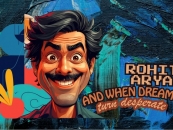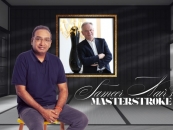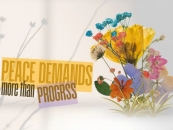-853X543.jpg)
HOW WILL I KNOW PEACE
by HUMRA QURAISHI March 18 2023, 12:00 am Estimated Reading Time: 13 mins, 0 secsHumra Quraishi revisits the artist Satish Gujral and his words, as she tries to make sense of the polarisation and lack of representation of diversities in our institutions, which is threatening India’s democracy today.
Three years have passed since the Delhi pogrom took place. Even before the Spring of 2020 could arrive, came the news of the targeted attacks in North East Delhi. And, as violence peaked, so did the reports fill the media. The role of the communal brigades backed by the political mafia was apparent. The biases in the system, the police force were visible to everyone. The arrest of students and the victims of that pogrom was disturbing. Shockingly, the doctor at the Al-Hind Hospital, Dr Muhammad Ehtesham Anwar, was also named in the charge-sheet submitted by the police. A doctor who saved human lives during that mindless violence was named as one of the accused, really?
The political system and the administrative machinery under its control seemingly failed the Muslims. One has to speak to the survivors to understand how terrorized they were. After all, they were first in the firing line! They had heard hollow political speeches. They knew they were at the mercy of the hate-filled Hindutva brigades.
I’ve been going through reports of the riots taking place everywhere in the country. Crucial points stand out. Riots are made to happen - they cannot take place without the knowledge of the police and other agencies. Also, if the administration wants, it can control riots within no time. Although I have before me several volumes on the communal riots in India, the most comprehensive is ‘Communal Riots - The State and Law in India’. Published by the Institute of Objective Studies, and edited by Iqbal Ansari, this volume carries ground reports by several IPS officers, civil servants and academics, also well-known legal luminaries – Padam Rosha, KF Rustamji, CV Narasimhan, VN Rai, NC Saxena, Justice Hosbet Suresh, Justice VR Krishna Iyer, VM Tarkunde.
These are detailed reports, with focus on the horrifying disasters that came along with each riot. Also, highlighted in several of these reports is the biased role of the police. Professor Satish Saberwal and Professor Mushirul Hasan's study of the Moradabad riots (1980) focuses on the role of the police: “The city's police, for long weeks, acted rather like a force organized to beat, loot and kill the Muslims. The PAC, in particular, collaborated with communal elements and goondas to bring about an open clash between Hindus and Muslims.”
Veteran police officers, VN Rai and Padam Rosha, have also made note of the fact that there was inadequate, and, on occasions the near-absence or negligible number of Muslims and other weaker sections of society in the police and paramilitary forces, making the Amnesty International characterize the PAC as a Hindu paramilitary force. AG Noorani has also commented on the near-exclusion of minorities from police and paramilitary forces.
Although in a democracy the composition of the Police and Paramilitary should not matter, it becomes important if the democracy itself is going through a crisis. If fascist forces are making marked intrusions into day-to-day lives of the citizens, then focus automatically dwells on the State machinery. And in such a dismal scenario, the Indian Muslim’s insecurity is bound to get compounded by the low to very low representation of the Muslims in the police force and the paramilitary.
In fact, during the course of an interview, academic-author Omar Khalidi had told me in January 2010 (months before his death), "Most of the intelligence agencies and paramilitary forces in India do not mirror the diversity of the national population.” Khalidi had also said that the decision of keeping Muslims out of the police force wasn’t a recent one but taken years ago. To quote him, "When on the recommendation of the National Integration Council (NIC) in 1969, the Home Minister YB Chavan merely broached the idea of recruiting Muslims in the police force, the Bharatiya Jana Sangh (BJS), the precursor to the Bharatiya Janata party (BJP), opposed it by calling it 'an invitation to disaster.'”
1.jpg)
Today, I want to revisit Satish Gujral, who passed away at the age of 94 on March 26th 2020. In the early 1980s when I had visited his home for the first time in New Delhi’s Lajpat Nagar, I hadn’t seen a more beautifully done-up home. That was the time I had to interview him for a magazine and was distracted with the picture-perfect home, his beautiful wife and the warmth they extended to me. He had a tremendous personality. Because he had a hearing disability, it was only through his wife that one could communicate with him. Once he would start talking, his bright sharp eyes would take over, conveying a whole array of emotions and expressions.
Satish came across as emotional and forthright. If one were to read his autobiography, A Brush With Life, it gets writ large that he didn’t shy away from writing the details of his struggles. He didn’t bypass any of the personal differences he had with important personalities like Indira Gandhi and MF Husain.
Even during the interviews, he would speak whole-heartedly, commenting on a range of subjects and his passions - art and architecture. I recall asking him about how he coped with the low phases in his life, he was injured as a child whilst swimming in the Lidder (River Lidder runs through Pahalgam in Kashmir) and that resulted in high fever, infections and the loss of hearing.
“Yes, tough phases, especially in view of the fact that in our country a physical problem or a visible handicap is sneered at and nobody spares you. Why take my case alone - hasn’t Surdas always been referred to as a blind poet, Taimur mentioned as lame? There are also sayings like andhe ko andha kaho aur phir uska gussa saho (call a blind a blind and deal with his anger). It’s the weakest people who sneer at weak people. Yes, I was sneered at and that left me hurt and bruised. At times I was so hurt that I couldn’t sleep at night. After we shifted from Jhelum to Lahore, I was called ‘Bola’ (deaf) by kids in the new school. For a while I didn’t realise I was called Bola. One day I was looking at the attendance register and I saw the word Bola. I asked another boy who was this boy named Bola. He told me that since I was deaf, I was called so. This remark came as a shock. But, that was not just one incident. Wherever my father took me for admission to a school or college, there were some hurdles, but my father never took ‘no ‘for an answer. Even in the arts college in Lahore and later the JJ School of Arts in Mumbai, my hearing problem came in the way at the time of admission. In Lahore my father had met the then chief minister Sir Sikander Hayat, who made sure I attended the arts classes on an informal basis. Later, in 1948, I got a job as a graphic artist in the Department of Public Relations of the Punjab Government, but I was kicked off after a while because I was told I was deaf. I realised that the only way to survive was through self-employment. I went to my father’s home in Jalandhar, where the family had settled down, and took to painting.”
Satish told me about several instances when he didn’t even have a rupee on him. “I went through phases of stress and financially tight times. But I feel that stress provokes creativity. Also, the fact that when I was actually going through those tough times I didn’t really feel they were difficult. At times I didn’t even have a single rupee. Once I didn’t have money to reach home from the railway station and my brother Inder had to come and fetch me. What kept me going was the belief that I should never give up. I have always worked, no matter what happened. Maybe changed the medium - like from painting to drawing architectural designs but I never gave up! I do not like the word despair. I’d say instead there could be an overwhelming doubt in my being but, then, my life has been a continuous process to eliminate the stillness and to build confidence… this is what I have been portraying right from what I’d witnessed during the Partition.”
Yes, he didn’t ever give up. And that turning point did come in his life - his going to Mexico to study on a scholarship. “Yes, call it a turning point, although I had zero chances… even my knowledge of English was minimum but nevertheless I did go for the interview. Someone had advised me that whilst answering questions I should look straight at the Mexican cultural attaché who was said to be part of the selection panel. But how was I to spot him among the Indians who had a similar complexion. I was told that Mexicans had Mongoloid features. So holding one canvas each, my brother Inder (Inder Gujral) and I walked to the appointed room and once the interview proceeded, I kept looking straight towards one particular gentleman who had those slanted eyes and high cheekbones. I was sure that he was the attaché. Later, I was told that that diplomat hadn’t turned up at all and the man I was gazing at was the Joint Secretary, Education, MG Saiyadain. Totally disappointed, I left for Jalandhar the same night, sure that nothing would come by, for my case was hopeless. But, then came another turn of events. An architect friend Ted Bower had been in love with an Indian writer, Shantha Rama Rau, and though she lived in the US, she had come down to Delhi and knew that particular Mexican diplomat who turned out to be none other than Octavio Paz. He recommended my name for that scholarship.”
Perhaps, another of those turning points was his marriage to Kiran. I always saw them happy together. Satish told me that the three times they were away from each other for a few days was when she was admitted in the maternity clinics to deliver their three kids! He added that for a marriage to survive, a couple should have a common interest or focus in life. “Both of us have the same interests. Kiran is not just a trained artist but also my best critic. So we always have something to discuss and argue over.”
1.jpg)
And yes, he was prudent enough to keep away from his female friends, “After my marriage with Kiran, I didn’t let any friendship develop into an affair. Yes, I was tempted but what actually prevented me from furthering any friendship is the fact that I am no fool to lose Kiran.”
Commenting on the fact that he was drawn to the Left ideology he explained, “Today I call myself a Leftist but not a communist. Why? Because in those early days when I was drawn to the communist party and later travelled on scholarship to Mexico and then to New York and intermingled with several communists, I was disillusioned. In Mexico, I met many Russian artists who told me what had been happening in Russia and it opened my eyes. Today I call myself a Leftist and not a communist.”
And when I had nudged him to comment on the political scene in the country he sounded disillusioned with the political parties and with the general prevailing scenario in the country. "What’s happening shows a lack of tolerance in the society. Economic development does not mean it will translate into spiritual development - economic development could also produce greater intolerance. After all, the US is the richest country, but see what they are doing in Afghanistan or to their own coloured people. Economic growth does not mean tolerance. I think the only solution to combat this intolerance is not economic growth but education. It is only through education that you know about different people and there’s less ignorance about the other. It is ignorance about the other that creates misunderstandings."
He spoke about the Partition and with that about his birth place in Pakistan without bitterness or anger. Only sadness, “I’d stayed back with my father in Pakistan (after the Partition) for some months and what disasters I saw! Usually it would take just about three hours to reach Jhelum from Lahore but those days it would take 10 hours or even longer because of the killings going on and here let me also say that it’s the outsiders who came and killed and not the locals. Our own family in Jhelum was protected from the Afghan raiders by Raja Ghazanfar Ali.”
Satish didn’t hide the fact that he was emotionally connected to Pakistan. When he travelled to Lahore in 1986, the very first time after the Partition, he was so emotionally overwhelmed that he suffered a heart attack and had to be admitted to hospital for a week. Thereafter he travelled just once more to Lahore, with the former prime minister Atal Bihari Vajpayee. He said he has an emotional link with Lahore - he has several close friends there. Recounting a touching incident, Gujral said, "When I suffered that heart attack in a hotel in Lahore, Kiran didn’t know what to do, where to take me. She called one of our lawyer friends Etajaz Hussain and told him about my condition. He was appearing in the court, arguing a case, but in the middle of an argument he apologised to the judge and rushed to take me to the hospital. Tell me who will do that."
He was hopeful that the strained relations with Pakistan could ease at some stage. Why that lingering hope? "What makes me hopeful is that there’s a growing feeling in Pakistan’s younger generation that there should be no baggage of the past and both countries could benefit on the economic front by joint collaboration. The fact that there’s great disillusionment in Pakistan vis-a-vis the army, it is surprising how warmly the people of the two countries meet, especially when they are meeting abroad. Because they share the same heritage, the same roots." Yet, it was surprising that he had not taken any of his solo shows to Pakistan! Why? To that he’d simply smiled in that boyish childlike way and said with an abundance of emotions that he would be happy, very happy doing so in the near future. Perhaps, that moment never came.
I’m ending, today, with this verse of KIRAN BHAT from the volume ‘Amity Peace Poems’ (Hawakal Publishers):
A Loud Noise Asked:/When will you find peace?/Kiran says:/I ought to stop listening to what my family says/First, I will be able to listen to myself/Then, my purpose will come/Then, I will follow my purpose/Then, I will know peace.





-173X130.jpg)

-173X130.jpg)
-173X130.jpg)


